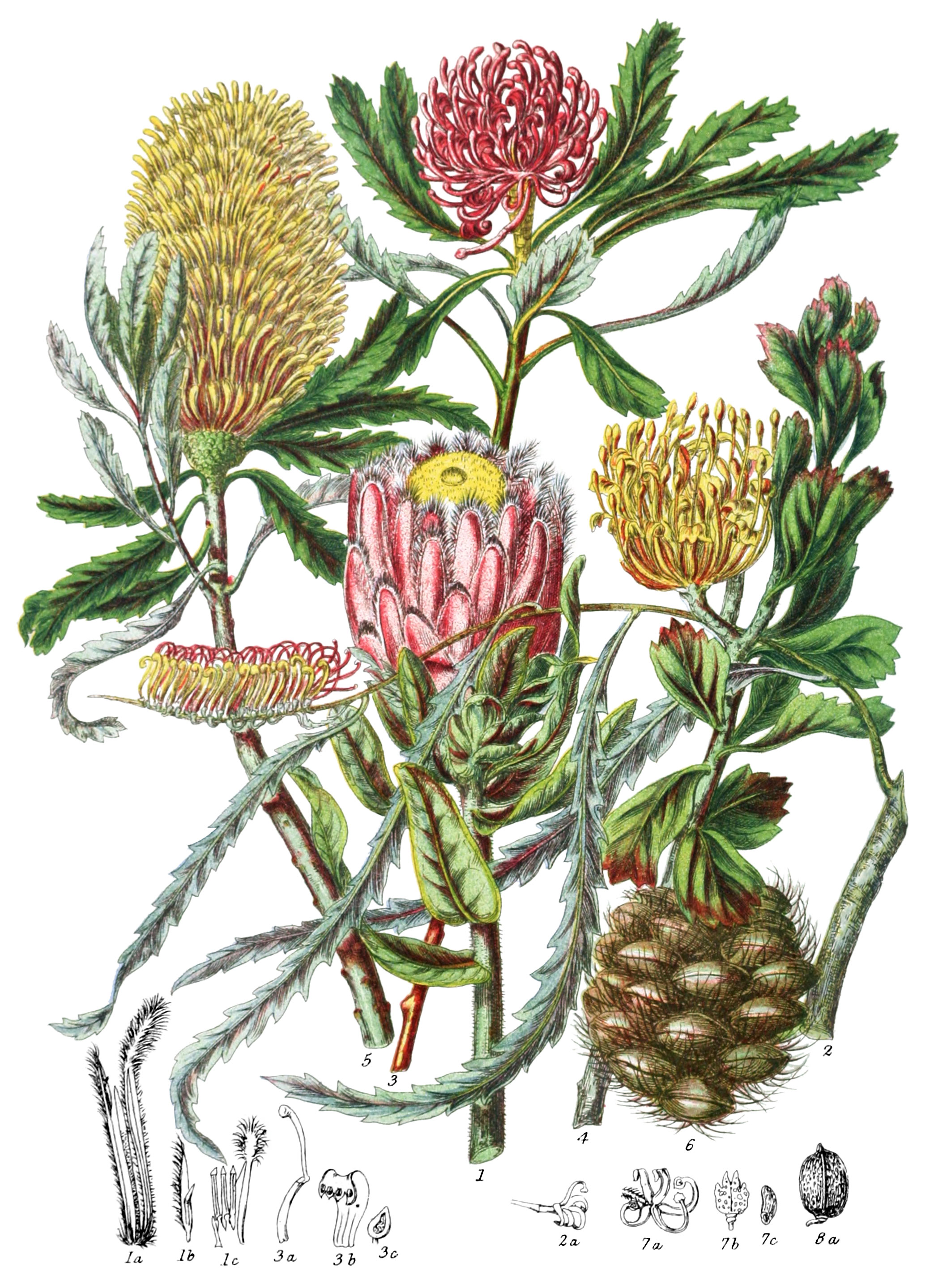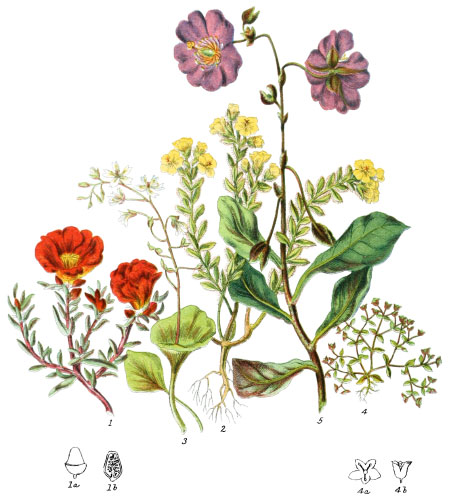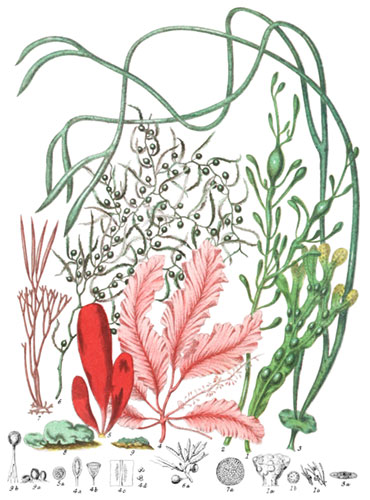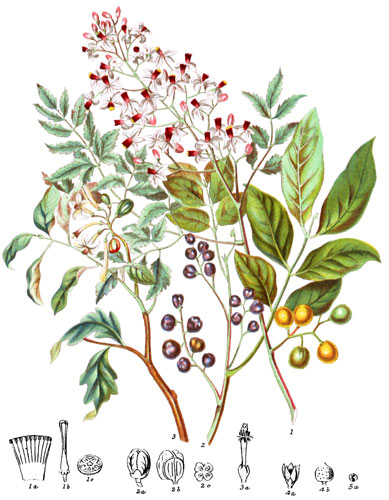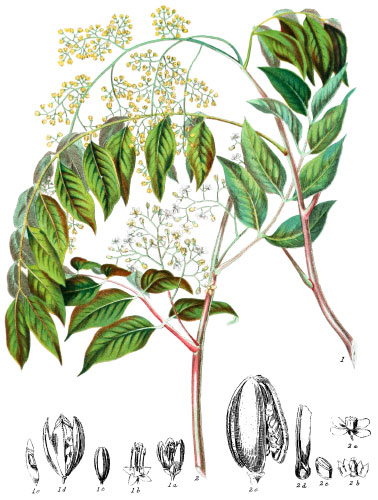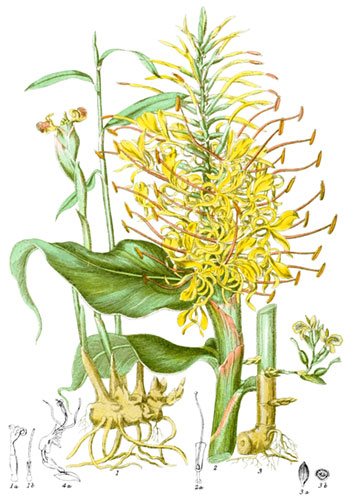Key characteristics
Small trees and shrubs, the branches usually in umbels. The leaves are rigid, dry, divided or undivided, opposite or alternate, without stipules, sometimes having pores equally on both sides. The calyx is four-lobed, or four-cleft; petals are wanting. The stamens are four, sometimes part imperfect, opposite the segments of the calyx, placed upon them. The ovary consists of a simple carpel above the calyx; the style is single, usually very long; the stigma simple. The fruit is gaping when ripe, or closed, and contains one or more seeds which have no albumen.
This Tribe has some affinity with Thymelaceæ, but is distinguished by the stamens of the lobes of the calyx, and the gaping fruit.
Very few useful properties exist in these plants; the seeds of some are eatable.
Select plants in this order
Not all plants listed are illustrated and not all plants illustrated are listed.
- Protea displays considerable varieties in species, and other genera being of extremely differing aspect, the name is well applied to the whole Tribe.
- P. pulchella (1) is one of the fairest examples in regard to the flower and general aspect, but the character of the Tribe is dull, stiff foliage, and the heads of small flowers afford very little beauty of bright colouring. Like many Australian trees and shrubs, a pale dusky hue pervades the leaves, sometimes not only on the under, but also on the upper surface.
- P. grandiflora rises to the size of a tree eight feet high, and is called Wagenboom by the Dutch colonists at the Cape, as they use the wood for the wheels of their strong rude carts. The bark is valued for medicinal properties.
- P. mellifera yields a kind of honey in some abundance, which is thought to be a remedy for coughs.
- The bark of P. speciosa is used in tanning leather.
- Nearly all the genera have been named after the learned botanists, Banskia, Lambertia, Persoonia, Dryandra, Hakea, and others, all recording the memory of celebrated men.
- Grevillea, so called from a nobleman who was a great promoter of general science, is very abundant in New South Wales.
- G. longifolia (2), is an elegant species when in flower, the extremely long styles bent backwards, giving a singular effect to the flower-spike.
- Telopea speciosissima (3), is of a brilliant colour and considered ornamental in the conservatory, although seldom seen in its full vigour; it is best known by its native name of Waratah.
- Leucospermum is named from the whiteness of the seeds; the shrubs are usually downy or hairy, and the heads of flowers stand erect at the ends of the branches.
- The leaves of L. hypophyllum (4) have, like those of those other species, a few strong notches at the end of leaves. This is peculiarly a Cape genus, and some of the species were amongst the first importations we obtained from that settlement in 1774.
- Banksia was named by Linnæus in honour of his friend Sir Joseph Banks, who, although younger, had already attained to great eminence as a naturalist. It is an Australian genus of noble aspect, and has the peculiar character of bearing the produce of four years on the tree at the same time: the dry hard seed-vessels of the two previous years, the cone of expanded flowers of the present season, and the buds of the future year.
- B. media (5) is a fine shrub in our conservatories, but all these shrubs can only flourish in a spacious airy building, a moist atmosphere is very uncongenial to their nature.
- B. speciosa (6) bears a large cone-shaped fruit, which seems to form a kind of link with the Fir Tribe, as also does the rigid foliage: the two-valved capsule gapes when ripe.
- B. grandis is said to attain a great size on the barren hills on the banks of the Swan River; some trees have been found fifty feet high, and more than two and a half in diameter.
- Dryandra is a very similar genus, the leaves are all more or less clothed with fine white down on the under surface, and the bracts of the flowers extremely silky.
- D. plumosa has a remarkably delicate pinnated leaf, the small triangular leaflets tipped with a fine point.
- Hakea is a shrub with very stiff foliage, the seed-vessel (7)* is a follicle of a woody nature, containing two winged seeds.
- Hakea undulata bears a large seed-vessel, and has wavy prickly-toothed leaves.
- Amongst these shrubs very few afford food of any kind; the seeds of Brabejum stellatum, the African almond of the Cape, when roasted are eaten like chesnuts, and their outer covering is used as coffee.
- The nut-like fruit of Guevina is sold in the markets of Chile.
- The flowers of Persoonia macrostachya and Petrophila brevifolia yield a bright colour when boiled, which might doubtless be available for dyeing.
- Lomatia, Stenocarpus, Nivenia, and several others, are natives of the Cape of Good Hope.
Locations
This Tribe is most abundant at the Cape, and in Australia. A few species only belong to South America, and the Isles of the Malay Archipelago. In the Northern Hemisphere Protea abyssinica and P. Paulina are almost the only examples.
Legend
- Protea pulchella, Wave-leaved Protea. Cape of Good Hope.
- Flower with Pistil.
- Stamen.
- Three Stamens.
- Grevillea longifolia, Long-leaved Grevillea. Australia.
- Flower of G. linearis.
- Telopea speciosissima, Waratah. New South Wales.
- Pistil.
- Calyx and Stamens.
- Anther.
- Leucospermum hypophyllum, Trifid-leaved Leucospermum. Cape of Good Hope.
- Banksia media. New Holland.
- B. speciosa. Fruit.
-
- Hakea acicularis.
- Fruit.
- Seed.
-
- Hakea undulata. Seed-vessel.
*7 was mentioned in the original description but only 7a–7c were illustrated. The Hakea seed vessel is 8a and not 7.
Explore more
Posters
Decorate your walls with colorful detailed posters based on Elizabeth Twining’s beautiful two-volume set from 1868.
Puzzles
Challenge yourself or someone else to assemble a puzzle of all 160 botanical illustrations.
